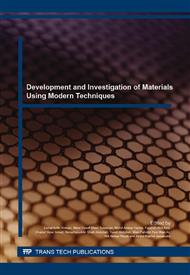[1]
Far Infrared Therapy, (n. d. ).
Google Scholar
[2]
R. Beever, Do Far-infrared Saunas Have Cardiovascular Benefits in People with Type 2 Diabetes?, Can. J. Diabetes. 34 (2010) 113–118.
DOI: 10.1016/s1499-2671(10)42007-9
Google Scholar
[3]
T. Tunç, A.Ş. Demirkıran, The effects of mechanical activation on the sintering and microstructural properties of cordierite produced from natural zeolite, Powder Technol. 260 (2014) 7–14.
DOI: 10.1016/j.powtec.2014.03.069
Google Scholar
[4]
S. Wang, D. Zhou, Z. Hou, M. Wang, X. Hu, X. Liu, Low-temperature sintering, low-dielectric cordierite ceramic tapes for high frequency application, Ceram. Int. 39 (2013) 9505–9509.
DOI: 10.1016/j.ceramint.2013.05.069
Google Scholar
[5]
P. Orosco, M. del C. Ruiz, J. González, Synthesis of cordierite by dolomite and kaolinitic clay chlorination. Study of the phase transformations and reaction mechanism, Powder Technol. 267 (2014) 111–118.
DOI: 10.1016/j.powtec.2014.07.009
Google Scholar
[6]
J. Banjuraizah, H. Mohamad, Z.A. Ahmad, Effect of impurities content from minerals on phase transformation, densification and crystallization of α-cordierite glass-ceramic, J. Alloys Compd. 509 (2011) 7645–7651.
DOI: 10.1016/j.jallcom.2011.04.129
Google Scholar
[7]
H.C. Li, D.G. Wang, X.G. Meng, C.Z. Chen, Effect of ZrO(2) additions on the crystallization, mechanical and biological properties of MgO-CaO-SiO(2)-P(2)O(5)-CaF(2) bioactive glass-ceramics., Colloids Surf. B. Biointerfaces. 118 (2014) 226–33.
DOI: 10.1016/j.colsurfb.2014.03.055
Google Scholar
[8]
A.A. Albhilil, M. Palou, J. Kozánková, Characterization of cordierite-mullite ceramics prepared from natural raw materials, Acta Chim. Slovaca. 6 (2013) 1–7.
DOI: 10.2478/acs-2013-0001
Google Scholar
[9]
B.E. Yekta, P. Alizadeh, L. Rezazadeh, Synthesis of glass-ceramic glazes in the ZnO–Al2O3–SiO2–ZrO2 system, J. Eur. Ceram. Soc. 27 (2007) 2311–2315.
DOI: 10.1016/j.jeurceramsoc.2006.08.009
Google Scholar
[10]
M. Romero, J.M. Rincón, A. Acosta, Crystallisation of a zirconium-based glaze for ceramic tile coatings, J. Eur. Ceram. Soc. 23 (2003) 1629–1635.
DOI: 10.1016/s0955-2219(02)00415-6
Google Scholar
[11]
L.M. Schabbach, F. Bondioli, A.M. Ferrari, C.O. Petter, M.C. Fredel, Colour in ceramic glazes: Efficiency of the Kubelka–Munk model in glazes with a black pigment and opacifier, J. Eur. Ceram. Soc. 29 (2009) 2685–2690.
DOI: 10.1016/j.jeurceramsoc.2009.02.019
Google Scholar
[12]
L.M. Schabbach, F. Bondioli, M.C. Fredel, Colouring of opaque ceramic glaze with zircon pigments: Formulation with simplified Kubelka–Munk model, J. Eur. Ceram. Soc. 31 (2011) 659–664.
DOI: 10.1016/j.jeurceramsoc.2010.11.039
Google Scholar
[13]
L.M. Schabbach, F. Bondioli, A.M. Ferrari, T. Manfredini, C.O. Petter, M.C. Fredel, Influence of firing temperature on the color developed by a (Zr, V)SiO4 pigmented opaque ceramic glaze, J. Eur. Ceram. Soc. 27 (2007) 179–184.
DOI: 10.1016/j.jeurceramsoc.2006.04.180
Google Scholar


